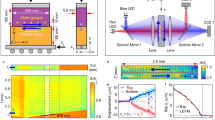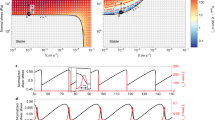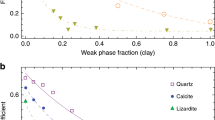Abstract
Earthquakes have long been recognized as resulting from a stick–slip frictional instability. The development of a full constitutive law for rock friction now shows that the gamut of earthquake phenomena—seismogenesis and seismic coupling, pre- and post-seismic phenomena, and the insensitivity of earthquakes to stress transients—all appear as manifestations of the richness of this friction law.
This is a preview of subscription content, access via your institution
Access options
Subscribe to this journal
Receive 51 print issues and online access
$199.00 per year
only $3.90 per issue
Buy this article
- Purchase on Springer Link
- Instant access to full article PDF
Prices may be subject to local taxes which are calculated during checkout






Similar content being viewed by others
References
Cowie, P. A. & Scholz, C. H. Growth of faults by the accumulation of seismic slip. J. Geophys. Res. 97, 11085–11095 (1992).
Scholz, C. H. Wear and gouge formation in brittle faulting. Geology 15, 493–495 (1987).
Gilbert, G. K. Atheory of the earthquakes of the Great Basin, with a practical application. Am. J. Sci. XXVII, 49–54 (1884).
Brace, W. F. & Byerlee, J. D. Stick slip as a mechanism for earthquakes. Science 153, 990–992 (1966).
Dieterich, J. Time-dependence of rock friction. J. Geophys. Res. 77, 3690–3697 (1972).
Scholz, C., Molnar, P. & Johnson, T. Detailed studies of frictional sliding of granite and implications for the earthquake mechanism. J. Geophys. Res. 77, 6392–6406 (1972).
Stesky, R. et al. Friction in faulted rock at high temperature and pressure. Tectonophysics 23, 177–203 (1974).
Rabinowicz, E. The intrinsic variables affecting the stick-slip process. Proc. Phys. Soc. (London) 71, 668–675 (1958).
Dieterich, J. Time dependent friction and the mechanics of stick slip. Pure Appl. Geophys. 116, 790–806 (1978).
Scholz, C. H. The Mechanics of Earthquakes and Faulting (Cambridge Univ. Press, (1990)).
Scholz, C. H. & Engelder, T. Role of asperity indentation and ploughing in rock friction. Int. J. Rock Mech. Min. Sci. 13, 149–154 (1976).
Wang, W. & Scholz, C. H. Micromechanics of the velocity and normal stress dependence of rock friction. Pure Appl. Geophys. 143, 303–316 (1994).
Dieterich, J. Modelling of rock friction: 1. Experimental results and constitutive equations. J. Geophys. Res. 84, 2161–2168 (1979).
Ruina, A. L. Slip instability and state variable friction laws. J. Geophys. Res. 88, 10359–10370 (1983).
Heslot, F., Baumberger, T., Perrin, B., Caroli, B. & Caroli, C. Creep, stick-slip, and dry friction dynamics: experiments and heuristic model. Phys. Rev. E 49, 4973–4988 (1994).
Dieterich, J. H. & Kilgore, B. Direct observation of frictional contacts: new insights for state-dependent properties. Pure Appl. Geophys. 143, 283–302 (1994).
Byerlee, J. D. Friction of rock. Pure Appl. Geophys. 116, 615–626 (1978).
Segall, P. & Rice, J. R. Dilatancy, compaction, and slip instability of a fluid infiltrated fault. J. Geophys. Res. 100, 22155–22171 (1995).
Gu, J. C., Rice, J. R., Ruina, A. L. & Tse, S. T. Slip motion and stability of a single degree of freedom elastic system with rate and state dependent friction. J. Mech. Phys. Solids 32, 167–196 (1984).
Beeler, N. M., Tullis, T. E. & Weeks, J. D. The roles of time and displacement in the evolution effect in rock friction. Geophys. Res. Lett. 21, 1987–1990 (1994).
Blanpied, M. L., Lockner, D. A. & Byerlee, J. D. Fault stability inferred from granite sliding experiments at hydrothermal conditions. Geophys. Res. Lett. 18, 609–612 (1991).
Scholz, C. H. The brittle-plastic transition and the depth of seismic faulting. Geol. Rundsch. 77, 319–328 (1988).
Shimamoto, T. Atransition between frictional slip and ductile flow undergoing large shearing deformation at room temperature. Science 231, 711–714 (1986).
Marone, C., Raleigh, C. B. & Scholz, C. Frictional behavior and constitutive modelling of simulated fault gouge. J. Geophys. Res. 95, 7007–7025 (1990).
Marone, C. & Scholz, C. The depth of seismic faulting and the upper transition from stable to unstable slip regimes. Geophys. Res. Lett. 15, 621–624 (1988).
Sibson, R. H. Fault zone models, heat flow, and the depth distribution of earthquakes in the continental crust of the United States. Bull. Seismol. Soc. Am. 72, 151–163 (1982).
Byrne, D. E., Davis, D. M. & Sykes, L. R. Loci and maximum size of thrust earthquakes and the mechanics of the shallow region of subduction zones. Tectonics 7, 833–857 (1988).
Hyndman, R. D. & Wang, K. Thermal constraints on the zone of major thrust earthquake failure: the Cascadia subduction zone. J. Geophys. Res. 98, 2039–2060 (1993).
Sibson, R. H. Transient discontinuities in ductile shear zones. J. Struct. Geol. 2, 165–171 (1980).
Stel, H. The effect of cyclic operation of brittle and ductile deformation on the metamorphic assemblage in cataclasites and mylonites. Pure Appl. Geophys. 124, 289–307 (1986).
Kanamori, H. & Kikuchi, M. The 1992 Nicaragua earthquake: a slow tsunami earthquake associated with subducted sediments. Nature 361, 714–716 (1993).
Irwin, W. P. & Barnes, I. Effects of geological structure and metamorphic fluids on seismic behavior of the San Andreas fault system in central and northern California. Geology 3, 713–716 (1975).
Ruff, L. & Kanamori, H. Seismicity and the subduction process. Phys. Earth Planet. Inter. 23, 240–252 (1980).
Zoback, M. L. & Zoback, M. D. Crustal stress and intraplate deformation. Geowissenshaften 15, 116–112 (1997).
Zoback, M. D. et al. New evidence on the state of stress of the San Andreas fault system. Science 238, 1105–1111 (1987).
Scholz, C. H. Faults without friction? Nature 381, 556–557 (1996).
Scholz, C. H. & Campos, J. On the mechanism of seismic decoupling and back-arc spreading in subduciton zones. J. Geophys. Res. 100, 22103–2212 (1995).
McCaffrey, R. Statistical significance of the seismic coupling coefficient. Bull. Seismol. Soc. Am. 87, 1069–1073 (1997).
Scholz, C. H. & Small, C. The effect of seamount subduction on seismic coupling. Geology 25, 487–490 (1997).
Seeber, L., Armbruster, J. G. & Quittmeyer, R. C. Seismicity and continental subduction in the Himalayan arc in Geodynamics Series, V (eds Gupta & Delany) 215–242 (Am. Geophys. Un., Washington DC, (1981)).
Amelung, F. & King, G. C. P. Earthquake scaling laws for creeping and non-creeping faults. Geophys. Res. Lett. 24, 507–510 (1997).
Nadeau, R., Foxall, W. & McEvilly, T. Clustering and periodic recurrence of microearthquakes on the San Andreas fault at Parkfield, California. Science 267, 503–507 (1995).
Bakun, W. H., Stewart, R. M., Bufe, C. G. & Marks, S. M. Implication of seismicity for failure of a section of the San Andreas fault. Bull. Seismol. Soc. Am. 70, 185–201 (1980).
Tse, S. & Rice, J. Crustal earthquake instability in relation to the depth variation of friction slip properties. J. Geophys. Res. 91, 9452–9472 (1986).
Rice, J. R. Spacio-temporal complexity of slip on a fault. J. Geophys. Res. 98, 9885–9907 (1993).
Thatcher, W. Nonlinear strain buildup and the earthquake cycle on the San Andreas fault. J. Geophys. Res. 88, 5893–58902 (1978).
Savage, J. C. & Prescott, W. H. Asthenospheric readjustment and the earthquake cycle. J. Geophys. Res. 83, 3369–3376 (1978).
Gilbert, L. E., Scholz, C. H. & Beavan, J. Strain localization along the San Andreas fault: consequences for loading mechanisms. J. Geophys. Res. 99, 23975–23984 (1994).
Savage, J. C. & Svarc, J. L. Postseismic deformation associated with the 1992 MW = 7.3 Landers earquake, southern California. J. Geophys. Res. 102, 7565–7577 (1997).
Das, S. & Scholz, C. Theory of time-dependent rupture in the earth. J. Geophys. Res. 86, 6039–6051 (1981).
Marone, C. J., Scholz, C. H. & Bilham, R. On the mechanics of earthquake afterslip. J. Geophys. Res. 96, 8441–8452 (1991).
Heki, K., Miyazaki, S. & Tsuji, H. Silent fault slip following an interplate thrust earthquake at the Japan trench. Nature 386, 595–598 (1997).
Dieterich, J. H. Aconstitutive law for rate of earthquake production and its application ot earthquake clustering. J. Geophys. Res. 99, 2601–2618 (1994).
Gross, S. & Kisslinger, C. Estimating tectonic stress rate and state with Landers aftershocks. J. Geophys. Res. 102, 7603–7612 (1997).
Dieterich, J. H. Nucleation on faults with rate and state-dependent strength. Tectonophysics 211, 115–134 (1992).
Ohnaka, M., Kuwahana, Y., Yamamoto, K. & Hirasawa, T. in Earthquakes Source Mechanics (eds Das, S., Boatwright, J. & Scholz, C.) 13–24 (AGU Monogr. 37, Am. Geophys. Un., Washington DC, (1986)).
Scholz, C. H. The critical slip distance for seismic faulting. Nature 336, 761–763 (1988).
Marone, C. & Kilgore, B. Scaling of the critical slip distance for seismic faulting with shear strain in fault zones. Nature 362, 618–622 (1993).
Abercrombie, R. & Leary, P. Source parameters of small earthquakes recorded ant 2.5 km depth, Cajon Pass, southern California: Implications for earthquake scaling. Geophys. Res. Lett. 20, 1511–1514 (1993).
Dodge, D. A., Beroza, G. C. & Ellsworth, W. L. Detailed observations of California foreshock sequences: Implications for the earthquake initiation process. J. Geophys. Res. 101, 22371–22392 (1996).
Ellsworth, W. L. & Beroza, G. C. Seismic evidence for a seismic nucleation phase. Science 268, 851–855 (1995).
Dieterich, J. H. Nucleation and triggering of earthquake slip: effect of periodic stresses. Tectonophysics 144, 127–139 (1987).
Heaton, T. H. Tidal triggering of earthquakes. Bull. Seismol. Soc. Am. 72, 2181–2200 (1982).
Hill, D. P. et al. Seismicity in the western United States triggered by the M 7.4 Landers, California, earthquake of June 28, 1992. Science 260, 1617–1623 (1993).
Cotton, F. & Coutant, O. Dynamic stress variations due to shear faults in a plane layered medium. Geophys. J. Int. 128, 676–688 (1997).
King, G. C. P., Stein, R. S. & Lin, J. Static stress changes and the triggering of earthquakes. Bull. Seismol. Soc. Am. 84, 935–953 (1994).
Power, W. L., Tullis, T. E., Brown, S., Boitnott, G. & Scholz, C. H. Roughness of natural fault surfaces. Geophys. Res. Lett. 14, 29–32 (1987).
Carlson, J. M. & Langer, J. S. Mechanical model of an earthquake fault. Phys. Rev. A 40, 6470–6484 (1989).
Myers, C., Shaw, B. & Langer, J. Slip complexity in a crustal plane model of an earthquake fault. Phys. Rev. Lett. 77, 972–975 (1996).
Shaw, B. E. Frictional weakening and slip complexity on earthquake faults. J. Geophys. Res. 100, 18239–18248 (1995).
Ben-Zion, Y. & Rice, J. R. Slip patterns and earthquake populations along different classes of faults in elastic solids. J. Geophys. Res. 100, 12959–12983 (1995).
Cochard, A. & Madariaga, R. Complexity of seismicity due to highly rate-dependent friction. J. Geophys. Res. 101, 25321–25336 (1996).
Ihmlé, P. F. & Jordan, T. H. Teleseismic search for slow precursors to large earthquakes. Science 266, 1547–1550 (1994).
Ihmlé, P. F. Monte Carlo slip inversion in the frequency domain: application to the 1992 Nicaragua slow earthquake. Geophys. Res. Lett. 23, 913–916 (1996).
Johnson, T. Time-dependent friction of granite: implications for precursory slip on faults. J. Geophys. Res. 86, 6017–6028 (1981).
Bak, P., Tang, C. & Wiesenfeld, K. Self-organized criticality. Phys. Rev. A 38, 364–374 (1988).
Acknowledgements
I thank L. Sykes and B. Shaw for comments. This work was partially supported by the US Geological Survey.
Author information
Authors and Affiliations
Rights and permissions
About this article
Cite this article
Scholz, C. Earthquakes and friction laws. Nature 391, 37–42 (1998). https://doi.org/10.1038/34097
Published:
Issue Date:
DOI: https://doi.org/10.1038/34097
This article is cited by
-
Gravity-induced seismicity modulation on planetary bodies and their natural satellites
Scientific Reports (2024)
-
Recurrence time and size of Chilean earthquakes influenced by geological structure
Nature Geoscience (2024)
-
Feedback responses between endogenous and exogenous processes at Campi Flegrei caldera dynamics, Italy
Bulletin of Volcanology (2024)
-
Laboratory Fracture Slip and Seismicity Subjected to Fluid Injection-Related Stress and Pressure Paths
Rock Mechanics and Rock Engineering (2024)
-
A review on slow earthquakes in the Japan Trench
Progress in Earth and Planetary Science (2023)
Comments
By submitting a comment you agree to abide by our Terms and Community Guidelines. If you find something abusive or that does not comply with our terms or guidelines please flag it as inappropriate.



